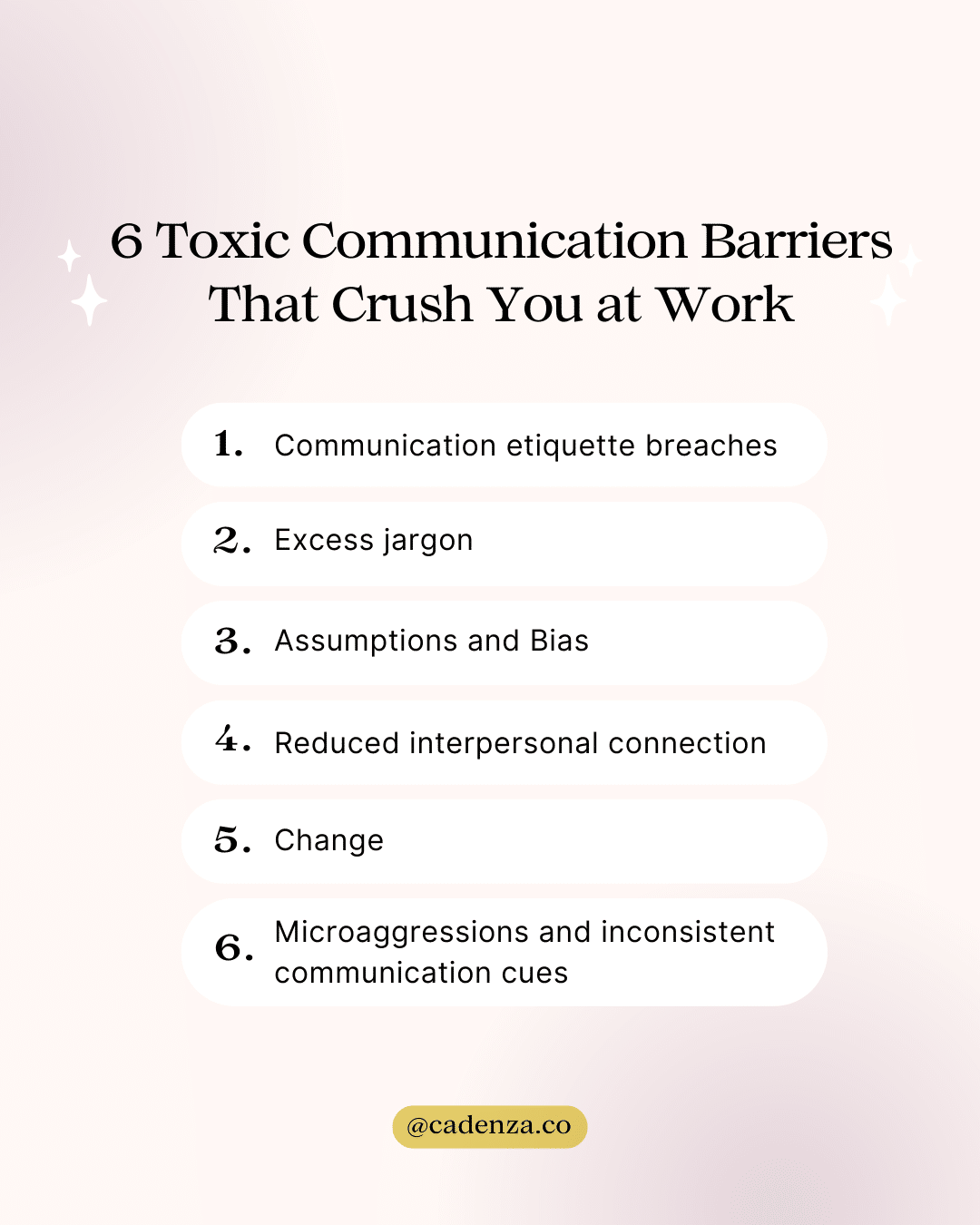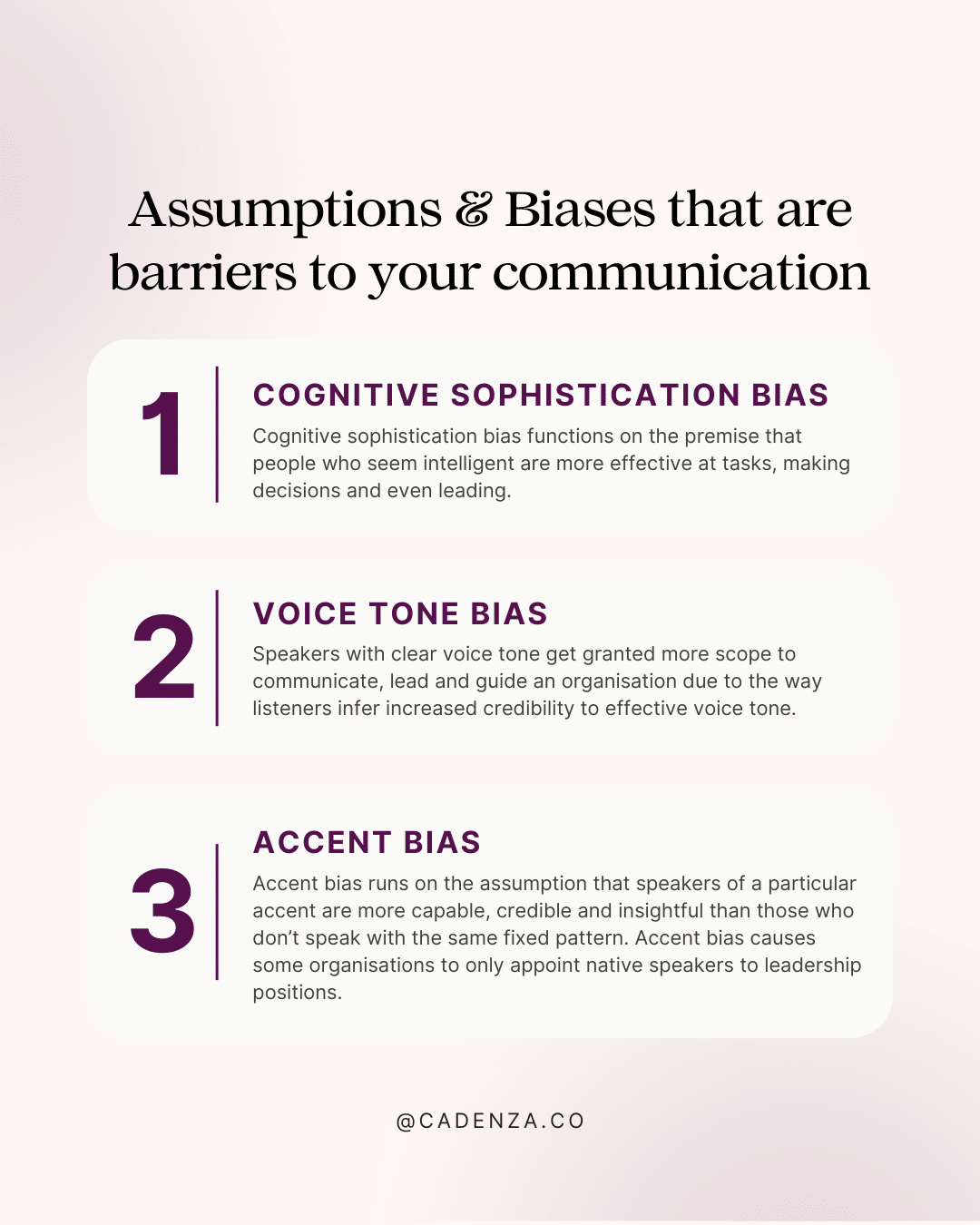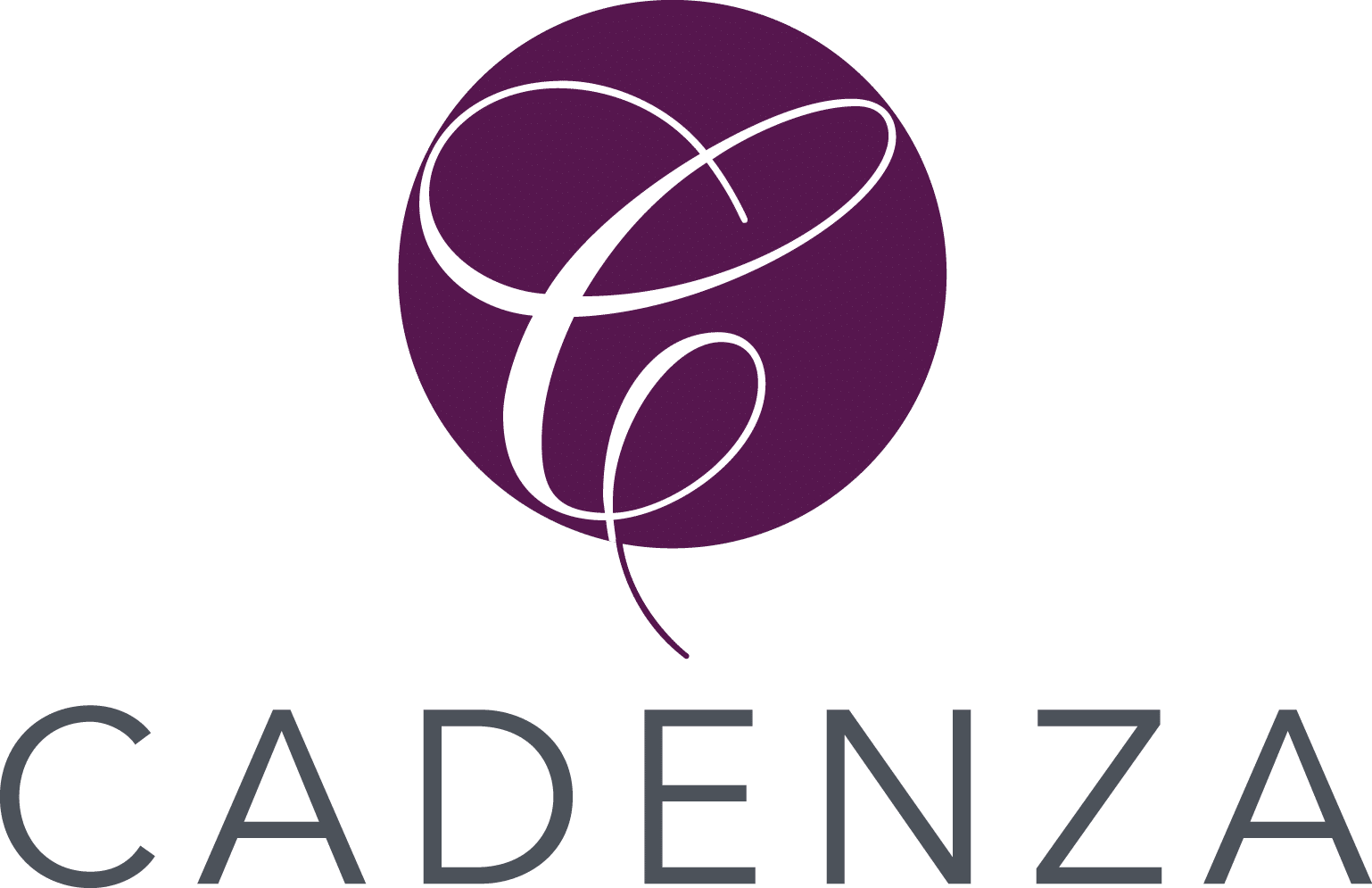Career Communication
Unblock 6 Toxic Communication Barriers That Crush You at Work
Learn about how to overcome communication barriers in the workplace

Work is like a jungle full of predators and threats. But it can also be enriching if you strive to decrease the communication barriers blocking your progress and comfort at work.
Today we’ll look at six strategies you can use immediately to reduce any communication barriers blocking your path to meaningful interactions and impact at work.
Each workplace is a unique ecosystem with personalities, processes and tasks that must work in sync to get valuable outcomes.
How smoothly and pleasantly you move through your KPIs is not always up to you!
Let’s investigate six barriers to effective workplace communication that will reduce your potential and impact or inhibit your team from interacting effectively.
Barrier #1 : Communication etiquette breaches
One key barrier to team confidence and effectiveness can come from etiquette breaches. Some examples of etiquette breaches include:
- Interruptions in meetings,
- Instances where someone claims an idea as their own (when it isn’t),
- Dominating conversations where the fast talkers lead the discussion without creating space and comfort for the more reflective communicators to add their input,
- Failure to interact with full attention while someone is talking,
- Ghosting via email,
- Running meetings over time.
Take a moment to think about your workplace, team, or employees. What score would you give your team for communication etiquette? What behaviours are people breaching?
If you’re a leader you can take action by setting up and enforcing ground rules for meetings and other activities.
Barrier #2: Excess jargon
At work, we tend to use specific jargon to define niche concepts and processes rapidly.
Jargon can be helpful because it allows professionals to exchange a code that everyone on the team understands rapidly. However, getting caught up in industry-specific acronyms and jargon is not ideal.
Jargon will also make you sound verbose and can create barriers if you discuss topics with contacts who work slightly outside your scope. Using excessive jargon is one behaviour that creates communication barriers in teams, especially when cross-disciplinary work is required.
Excess jargon often creates huge hierarchy boundaries because it operates on the exclusion principle. One study found that low-status team members tend to cling to jargon and use it to signal their status and access to niche knowledge (Brown, Ancich and Galinsky, 2021). So instead of fighting to use the latest “in-term”, focus on clarity and brevity.
So reduce jargon if you want to improve at creating clear and accessible communication! And if you’re a leader, you can permanently ban jargon altogether. Here’s what a former director of the BBC did to stop his team from using jargon or speaking off-topic. Greg Dyke set up a yellow card system for team meetings. Team members that circled topics and used too much jargon were carded (Brown, Acicich and Galinsky, 2021).
Take some time to think about how your organisation trains, rewards, and reinforces good communication behaviours. For example, is a guide in place for expectations around your team’s speaking tone? One principle could be jargon removal.

Barrier #3 : Assumptions and Bias
When we share an idea at work, bias will always impact how our message is received.
Let’s consider three biases that can cause barriers to effective communication at work.
- Cognitive sophistication bias: Many of your team may be held back by a bias towards people on the team who appear more intelligent than them. Cognitive sophistication bias functions on the premise that people who seem intelligent are more effective at tasks, making decisions and even leading. While this can be the case in many instances, cognitive sophistication bias can cause interaction barriers at work if you perceive others to hold more intellectual worth than you. As a result, you may be less inclined to try for leadership roles or even share your ideas.
- Voice tone bias: Speakers with clear voice tone get granted more scope to communicate, lead and guide an organisation due to the way listeners infer increased credibility to effective voice tone. If your voice tone is subpar, you can be held back professionally due to voice tone bias. People will engage less with your message, and you find it harder to gain a leadership position (Caballero, 2021). Like all assumptions and biases, this is unfair, but instead of feeling inhibited, the fastest way to override this bias is to work on your voice and ensure you know how to use it correctly.
- Accent bias: Accent bias runs on the assumption that speakers of a particular accent are more capable, credible and insightful than those who don’t speak with the same fixed pattern. Accent bias causes some organisations to only appoint native speakers to leadership positions. Further, speakers communicating in their second language are more likely to be interrupted in team meetings than native speakers, regardless of their language proficiency (Li, 1999). Have you noticed accent bias in your workplace? Accent bias poses a colossal equity and diversity malpractice. What can you do to amplify and provide a platform for your colleagues who may be affected by this?
Many more assumptions and biases exist that can cause barriers to workplace communication. Still, hopefully, these three have got you thinking about what biases may be holding employees back when interacting at work.

Barrier #4 : Reduced interpersonal connection
Time is a precious commodity in a task-heavy workplace, especially for leaders. Unfortunately, with a long list of responsibilities, many leaders prioritise revenue-defining processes at the expense of building interpersonal connections with their teams. If you know that the top of your to-do list prioritises activities that don’t involve much interpersonal communication, strive to become more systematic with incorporating communication activities with your team. These activities don’t need to be formal “engagement” events. Frequent, small acts of interaction with your team members will build your impact and influence on the team.
Consider the importance of connecting with your key players and schedule consistent attempts to interact. This could include joining the team for lunch once a month, leaving your desk for the coffee run with the group instead of working through it, short impromptu chats, and making a concerted effort to greet your colleagues in the office chat each morning. Investing in interpersonal connections on your team will always be worthwhile.
Don’t confuse friend-based interactions with connected professional relationships if you’re a leader. Your ability to inspire and influence your team will be reduced if you aim for the same kind of friendships you have outside of work. Keep it candid, warm and professional but not too informal, or your credibility and influence will drop. Leadership preferences among followers differ vastly from social friendship preferences (Laustsen and Petersen, 2015).
To lead your team effectively, you’ll need to showcase leadership communication behaviours distinct from friendship-style interactions while building trust and rapport.

Barrier #5 : Change
Change presents a volatile communication risk for any team or organisation.
If you’re leading a team, one of the most effective ways to reduce work pressure and frustration is to clearly understand your team member’s workflow. Try to become attuned to how their core daily tasks run and consider how much stability and constancy they receive in their role.
Analyse the change ratio. How much balance is there between stable processes and unexpected changes? If you notice that many of your team members’ KPIs and procedures are not transparent and easily replicable, it’s time to consider rolling out concrete systems that define workflow expectations. In doing this, remember that change creates communication barriers. Hypothesise when is the best moment for any change management conversations.
Innovative ideas and fresh approaches to improving your organisation are fantastic, but executing change takes tact and social intelligence.
You’ll want to outline expectations systematically with a delivery that inspires the uptake to mitigate the risk of change fatigue, resistance, and overall confusion (Neill, 2018). Changes will always emotionally impact employees (Neill, 2018), so working with an executive communication consultant to optimise rapport can be fruitful.
Set up strategic touch points where you engage in conversations that emphasise expectations around processes so that your team are clear on their workflow and the organisation’s unique systems that give your company a market advantage.
In my work with CEOs, Founders and Executives, it’s always fruitful to gauge how communication occurs around organisational systems and KPIs. Where needed, I’ll provide research-based tactics that allow operational conversations to happen without a communication glitch so that your team feels valued and supported in the face of change.
Barrier #6 : Microaggressions and inconsistent communication cues
Microaggression is the most toxic and potentially rampant workplace communication barrier that marginalises team members and deteriorates their health and well-being (Bond and Haynes, 2021).
Unfortunately, many organisations are still troubleshooting a system to address the harmful impact of micro aggressive behaviour. Microaggression often occurs behind closed doors in an insidiously covert way. Antisocial behaviour in the workplace tends to arise from poorly played power bids among sociopath/ narcissistic types seeking to crush and destroy any resistance or competition that gets in their way or dims their “star.”
Microaggressors tend to signal inconsistent communication cues. For example, they tow the etiquette line with duped smiles and false praise and then strike hard behind closed doors or with quick unheard verbal asides or derailing body language. A common outcome of microaggression is the feeling of confusion, where the victim starts second-guessing their perception of the conversation partner’s intent.
Because of the vague and subtle communication cues that make up microaggression, pinning evidence of the behaviour on the aggressor can be difficult.
Leaders need to be alert to microaggression and move rapidly into pulling rank and defining rules of civility across the organisation. If you notice incivility within your organisation, your role is to take action.
You might consider working with an executive communication consultant to refine company protocols around workplace communication tone.
You can also consider investing in communication training that builds up social intelligence. For example, consider hiring a communication expert to deliver research-based emotional intelligence strategies to your team. A communication scientist can provide empathy, rapport, assertive communication, self-advocacy, and diplomacy training. These skills will unite your team, reduce communication barriers in the workplace, mitigate communication injuries and even optimise the client experience.
Every workplace has vulnerable team members who need tools to self-advocate and set boundaries. If you let this slip, their performance will never actualise, retention will always be an issue, and your organisation’s reputation will suffer.
Suppose you’re a leader and a bystander to microaggression, or worse still, a perpetrator of microaggression; think seriously about investing in socially intelligent tactics to improve your interpersonal manner. Otherwise, your reputation and your team’s medical health are at stake (Campon and Rivera 2019).

Social intelligence is the portal to reducing communication barriers in the workplace.
Are your team receiving training in effective communication? If not, consider the scope for professional development to boost their capacities in this area.
Don’t leave employees to rely solely on their expertise and personality to communicate effectively in meetings and projects. Instead, invest in training to improve their speaking tools.
“Communication leads to community, that is, to understanding, intimacy and mutual valuing”
– Rollo May.
One of the simplest ways to increase the sense of worth among employees and the bottom line is to invest in communication strategy development.
And remember, leading doesn’t stop at setting up the processes and jumping ship! A floating boat can’t cut its course without a good captain. If you’re a leader, your role is to inspire your team to feel valued and take action. How can you build the communication agility of your team members so that communication barriers are minimised and each member of your organisation feels personally valued and inspired?
Free Class
Communication Class for Emerging Leaders

Inside, I’ll show you precisely what you need to do to showcase your skills as an emerging leader even if you’ve not been given a chance at a management position.
Did you enjoy this post? Make sure to subscribe to our YouTube channel to get more content to increase your communication skills!
References
-
Bond, M. and M. Haynes (2021). “Mobilizing bystanders to address microaggressions in the workplace: The case for a systems change approach to Getting A (Collective) GRIP.” American Journal of Community Psychology 69.
-
Z. Brown, E. Anicich, and A. Galinsky (2021). Does Your Office Have a Jargon Problem? Harvard Business Review, Harvard Business Review.
-
Laustsen, L. and M. B. Petersen (2015). “Does a competent leader make a good friend? Conflict, ideology and the psychologies of friendship and followership.” Evolution and Human Behavior 36(4): 286-293.
-
Campon, S. and Rivera, D (2019). Microaggressions: Toxic Rain in Health Care. Microaggression Theory: Influence and Implications. D. R. Gina Torino, Christina Capodilupo, Kevin Nadal, Derald Wing Sue. New Jersey, Wiley.
-
Neill, M. (2018). “Change Management Communication: Barriers, Strategies & Messaging.” The Public relations journal 12.
-
Parikh, A. K. and J. R. Leschied (2022). “Microaggressions in our daily workplace encounters: a barrier to achieving diversity and inclusion.” Pediatric Radiology.
-
Bond, M. and M. Haynes (2021). “Mobilizing bystanders to address microaggressions in the workplace: The case for a systems‐change approach to Getting A (Collective) GRIP.” American Journal of Community Psychology 69.
-
Shulman, H. C., Dixon, G. N., Bullock, O. M., & Colón Amill, D. (2020). The Effects of Jargon on Processing Fluency, Self-Perceptions, and Scientific Engagement. Journal of Language and Social Psychology, 39(5–6), 579–597. https://doi.org/10.1177/0261927X20902177
-
Spicer, A. (2018). “If We All Hate Business Jargon, Why Do We Keep Using It?” Harvard Business Review.
About the Author
Dr Sarah Lobegeiger de Rodriguez is a Keynote Speaker, Executive Speaking Coach, and Opera Singer who likes to play with words, sounds, and your impact.
Her academic background is in Music Performance, Communication Science and Speech & Language Pathology. She assists executive communication clients all over the world as a communication consultant with strong expertise in CEO, Founder and Entrepreneur communication strategies.
Connect with Sarah on LinkedIn.
© CADENZA
Level 14, 380 St Kilda Road, Melbourne, 3004
Privacy Policy
Terms & Conditions
Position Statement on Racism
